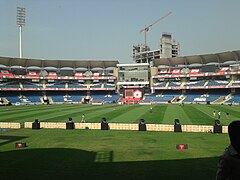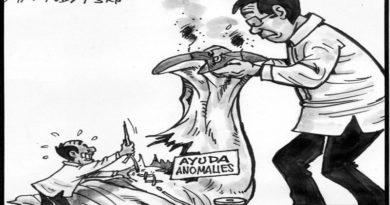FREE ASEAN | FREE MYANMAR: AFC Women’s Asian Cup play-offs: NAVI MUMBAI- Việt Nam beat Thailand 2-0
Việt Nam national women’s team vs Thailand in the play-offs of the AFC Women’s Asian Cup 2022. — Photo the-afc.com / By Thanh Nga
.
.
NAVI MUMBAI — Following the 3-1 win of the Vietnamese national men’s football team against China in the third round of World Cup qualification, more good news came in the Lunar New Year as the Việt Nam national women’s team beat Thailand 2-0 in the AFC Women’s Asian Cup 2022 play-offs, held in India on Wednesday afternoon.
Ads by:
Memento Maxima Digital Marketing
@[email protected]
SPACE RESERVE FOR ADVERTISEMENT
Việt Nam dominated the game right from the opening whistle, and Cù Huỳnh Như and Thái Thị Thảo scored the goals for Việt Nam in the first half.
In the 10th minute, Việt Nam had the first shot on the Thai goal, but striker and captain Huỳnh Như’s shot lacked power.
The Vietnamese team continuously broke through the Thai defence on the right wing, with good coordination between Nguyễn Thị Bích Thùy, Huỳnh Như and Hải Yến.
Though Việt Nam were dominant, Thailand were no pushovers with lots of strong wing play.
In the 18th minute, Huỳnh Như had a second chance to grab the opener for Việt Nam but couldn’t beat goalie Thai W. Boonsing.
However, a minute later, Huỳnh Như broke the deadlock on her third attempt. It was her second goal in the Women’s Asian Cup this year.
Ads by:
Memento Maxima Digital Marketing
@[email protected]
SPACE RESERVE FOR ADVERTISEMENT

In the 24th minute, the Vietnamese women’s team increased the score to 2-0 after Thảo’s header from a corner kick.
The Thai team tried to mount a comeback but could not break down the well-drilled Vietnamese defence.
Several minutes after the break, Huỳnh Như continued to excite fans with what looked like a third goal, but it was ruled out for offside after the referee consulted VAR.
Ads by:
Memento Maxima Digital Marketing
@[email protected]
SPACE RESERVE FOR ADVERTISEMENT
Thailand bounced back strongly to bring the ball closer to the Vietnamese goal, but could not get the ball into the penalty area.
Hải Yến had a good free kick from a favourable position in the 64th minute, but the ball hit a Thai defender’s foot and went out for a corner.
Although Thailand had more possession, Việt Nam controlled the game well and never looked in any real danger.
In the dying minutes, there was red-card drama as Thailand’s Kanchanaporn Saenkhun was sent off for bringing down Nguyễn Thị Thanh Nhã who was clear on goal.
The round-robin play-off includes three teams Chinese Taipei, Thailand and Việt Nam, all losing quarter-finalists. The winner of the play-offs will earn an automatic slot at the FIFA Women’s World Cup in Australia and New Zealand in 2023.
The next set of matches will see Thailand will play Chinese Taipei on Friday, and conclude with Chinese Taipei facing Việt Nam on Sunday. VNS
Ads by:
Memento Maxima Digital Marketing
@[email protected]
SPACE RESERVE FOR ADVERTISEMENT
Update: February, 02/2022 – 18:16
<>
TRIVIA
.
Navi Mumbai
|
Navi Mumbai
|
|
|---|---|
|
City
|
|
|
Form top to bottom:
Navi Mumbai Skyline, Vashi Sector 30A, Navi Mumbai Municipal Corporation, DY Patil Stadium |
|
| Coordinates: 19°01′N 73°01′ECoordinates: 19°01′N 73°01′E | |
| Country | India |
| State | Maharashtra |
| Districts | Includes parts of Thane, Raigad districts |
| Planned, Developed and Owned By | CIDCO, NMMC |
| Elevation | 14 m (46 ft) |
| Population | |
| • Total | 1,119,488 |
| Language | |
| • Official | Marathi |
| Vehicle registration | MH-43 (Navi Mumbai’s Thane district), MH-46 (Navi Mumbai’s Raigad district) |
Ads by:
Memento Maxima Digital Marketing
@[email protected]
SPACE RESERVE FOR ADVERTISEMENT
Navi Mumbai (Marathi pronunciation: [nəʋiː mumbəiː], is a planned city situated on the west coast of the Indian subcontinent, lies in Konkan division of Maharashtra state, on the mainland of India. Navi Mumbai is part of the Mumbai Metropolitan Region (MMR). The city is divided into two, North Navi Mumbai and South Navi Mumbai, for the individual development of Panvel Mega City, which includes the area from Kharghar to Uran, including Taloja node strictly in the city of Navi Mumbai. Though, NMMC doesn’t include these nodes in their jurisdiction because CIDCO is currently developing them, after developing these nodes it will be handed over to NMMC. Navi Mumbai has a population of 1,119,477[1] as per the 2011 provisional census. It has an average city elevation of 14 meters, excluding forest area.
The area was proposed in 1971 as a new urban township of Mumbai by the Government of Maharashtra. A new public sector undertaking, CIDCO, was established for this purpose.[2] Navi Mumbai is situated across two districts, Thane Part and Raigad.[3] The city has been ranked 4th among 73 cities surveyed for cleanliness and hygiene by the Union Ministry of Urban Development (MoUD)
Navi Mumbai (Marathi pronunciation: [nəʋiː mumbəiː], is a planned city situated on the west coast of the Indian subcontinent, lies in Konkan division of Maharashtra state, on the mainland of India. Navi Mumbai is part of the Mumbai Metropolitan Region (MMR). The city is divided into two, North Navi Mumbai and South Navi Mumbai, for the individual development of Panvel Mega City, which includes the area from Kharghar to Uran, including Taloja node strictly in the city of Navi Mumbai. Though, NMMC doesn’t include these nodes in their jurisdiction because CIDCO is currently developing them, after developing these nodes it will be handed over to NMMC. Navi Mumbai has a population of 1,119,477[1] as per the 2011 provisional census. It has an average city elevation of 14 meters, excluding forest area.
Ads by:
Memento Maxima Digital Marketing
@[email protected]
SPACE RESERVE FOR ADVERTISEMENT
The area was proposed in 1971 as a new urban township of Mumbai by the Government of Maharashtra. A new public sector undertaking, CIDCO, was established for this purpose.[2] Navi Mumbai is situated across two districts, Thane Part and Raigad.[3] The city has been ranked 4th among 73 cities surveyed for cleanliness and hygiene by the Union Ministry of Urban Development (MoUD) and Quality Council of India (QCI) as a part of Swachh Bharat Abhiyan.[4]
Navi Mumbai is home to various educational institutions offering courses in several streams including engineering, medical sciences, interior designing, and hotel management. Various multinational corporations like ACG Group, Aplab, Siemens, McDonald’s, Morningstar, Inc., Baker Hughes, Bureau Veritas, Bizerba, CRISIL, Reliance, Mastek, Accenture, Selcore Technology, Hexaware Technologies, firstsource, Hinduja Group, Larsen & Toubro, VENUS Safety and cyber security multinational Velox have their head offices/branches across the city, making it an active business hub. Navi Mumbai also has various recreational facilities such as a Golf Course, Central Park and Pandavkada Water Falls in Kharghar, Parsik Hill near CBD Belapur, Wonders Park and Jewel of Navi Mumbai in Nerul and Seawoods, Mini Seashore Juhu Chowpatty in Juhu Nagar (Juhu Gaon), Sagar Vihar in Vashi, Pirwad, Nagav, and Mankeshwar Beaches in Uran, Belapur Fort in CBD Belapur, Karnala Bird Sanctuary near Panvel, and several other public places like gardens and jogging tracks. Navi Mumbai also has many quality restaurants and luxury hotels for accommodation. There are many shopping malls, such as Seawoods Grand Central Mall in Seawoods, Little World Mall, Glomax Mall and Prime Mall in Kharghar, Orion Mall and K-Mall in Panvel, Centre One Mall, Inorbit Mall, Raghuleela Mall, Citi Centre and Palm Beach Galleria in Vashi. Navi Mumbai is also a host to many best health care centres and hospitals like MITR Hospital in Sector 05, Kharghar, Fortis Hiranandani Hospital near Juhu Village, Juhu Nagar (Vashi), Apollo Hospital in Belapur and SRL diagnostic centres in Kharghar, Panvel, Kamothe, Kalamboli, Koper Khairane, Juhu Gaon to name a few. Airoli is an important part of Navi Mumbai.
Ads by:
Memento Maxima Digital Marketing
@[email protected]
SPACE RESERVE FOR ADVERTISEMENT
History
India experienced a phenomenal rate of urban growth during the 25 years following independence and Mumbai always has had its due share in it. The population of Greater Mumbai rose from 2.966 million in 1951 to 4.152 million in 1961 and to 5.970 million in 1971, registering 40.0 and 43.80 percent growths during the first and second decades respectively. The rapid rate of growth of population, made possible by the increasing industrial and commercial importance of the city, resulted in a fast deterioration in the quality of life for the majority of people living in the city. Development inputs could not keep pace with the rapidly growing population, industry, trade and commerce. Besides, there are physical limitations to the growth of a city built on a long and narrow peninsula, which has very few connections with the mainland.
The Government of Maharashtra has been alive to the emerging problems of this metropolis. Responsible public opinion was equally vigilant and several constructive suggestions appeared from time to time in the press and elsewhere. All this helped in keeping the problems of Bombay in the forefront of public awareness. In 1958, the Govt. of Bombay appointed a study group under the Chairmanship of Shri S.G. Barve, Secretary to Government, Public Works Department, to consider the problems relating to congestion of traffic, deficiency of open spaces and playfields, shortage of housing and over-concentration of industry in the metropolitan and suburban areas of Bombay, and to recommend specific measures to deal with these.
Ads by:
Memento Maxima Digital Marketing
@[email protected]
SPACE RESERVE FOR ADVERTISEMENT
The Barve Group reported in February 1959. One of its major recommendations was that a rail-cum-road bridge is built across the Thane Creek to connect peninsular Mumbai with the mainland. The group felt that the bridge would accelerate development across the Creek, relieve pressure on the city’s railways and roadways, and draw away industrial and residential concentrations eastward to the mainland. The Group hoped that the eastward development would be orderly and would take place in a planned manner.
The Government of Maharashtra accepted the Barve Group recommendation. Another Committee under the Chairmanship of Prof. D.R. Gadgil, then Director of the Gokhale Institute of Politics and Economics, Poona was formed and asked: “to formulate broad principles of regional planning for the metropolitan regions of Mumbai Panvel and Pune and to make recommendations for the establishment of Metropolitan Authorities for preparation and execution of such plans”.
The Gadgil Committee inter-alia made two important recommendations which have influenced the planning for Navi Mumbai. One, a planned decentralisation of industries with severe restrictions on further industrial growth in the Bombay region. Two, development of the mainland area as a multi-nucleated settlement, each settlement smaller in size than 250,000 population. These multi-nucleated settlements are called nodes in the plan, where the entire development is proposed as a series of nodes strung out along the mass transit area. The nodes proposed by us are, however, more closely spaced than the multi-nucleated settlements envisaged by Dr. Gadgil. But the principle remains of individual settlements, self-contained in respect of schools and shopping and other essential services and separated from each other by green spaces.
Ads by:
Memento Maxima Digital Marketing
@[email protected]
SPACE RESERVE FOR ADVERTISEMENT
The Maharashtra Regional and Town Planning Act was passed in 1966 and brought into force in January 1967. The Bombay Metropolitan Region was notified in June 1967 and a Regional Planning Board constituted under the Chairmanship of Shri L.G. Rajwade, I.C.S. The Draft Regional Plan of the Board was finalised in January 1970. It proposed the development of a twin city across the harbour, on the mainland to the east, as a counter-magnet to the office concentration taking place at the southern tip of Bombay. The alternative growth pole was to siphon off the over-concentration of jobs and population which further growth would cause in the city and reallocate these on the mainland. In making this recommendation, the Board was influenced by various factors such as the existing industrial sites in the Than–Belapur area and Taloja, the imminent completion of the Thana Creek Bridge and the proposal of the Bombay Port Trust to establish a new port at Nhava Sheva.
The Board recommended that the new metro-centre or Navi Mumbai as it is now called, be developed to accommodate a population of 2.1 million.[5]
Ads by:
Memento Maxima Digital Marketing
@[email protected]
SPACE RESERVE FOR ADVERTISEMENT
Implementation, development and issues
.
READ MORE: https://en.wikipedia.org/wiki/Navi_Mumbai
__________________________________________

Ads by: Memento Maxima Digital Marketing
@[email protected]
SPACE RESERVE FOR ADVERTISEMENT
















